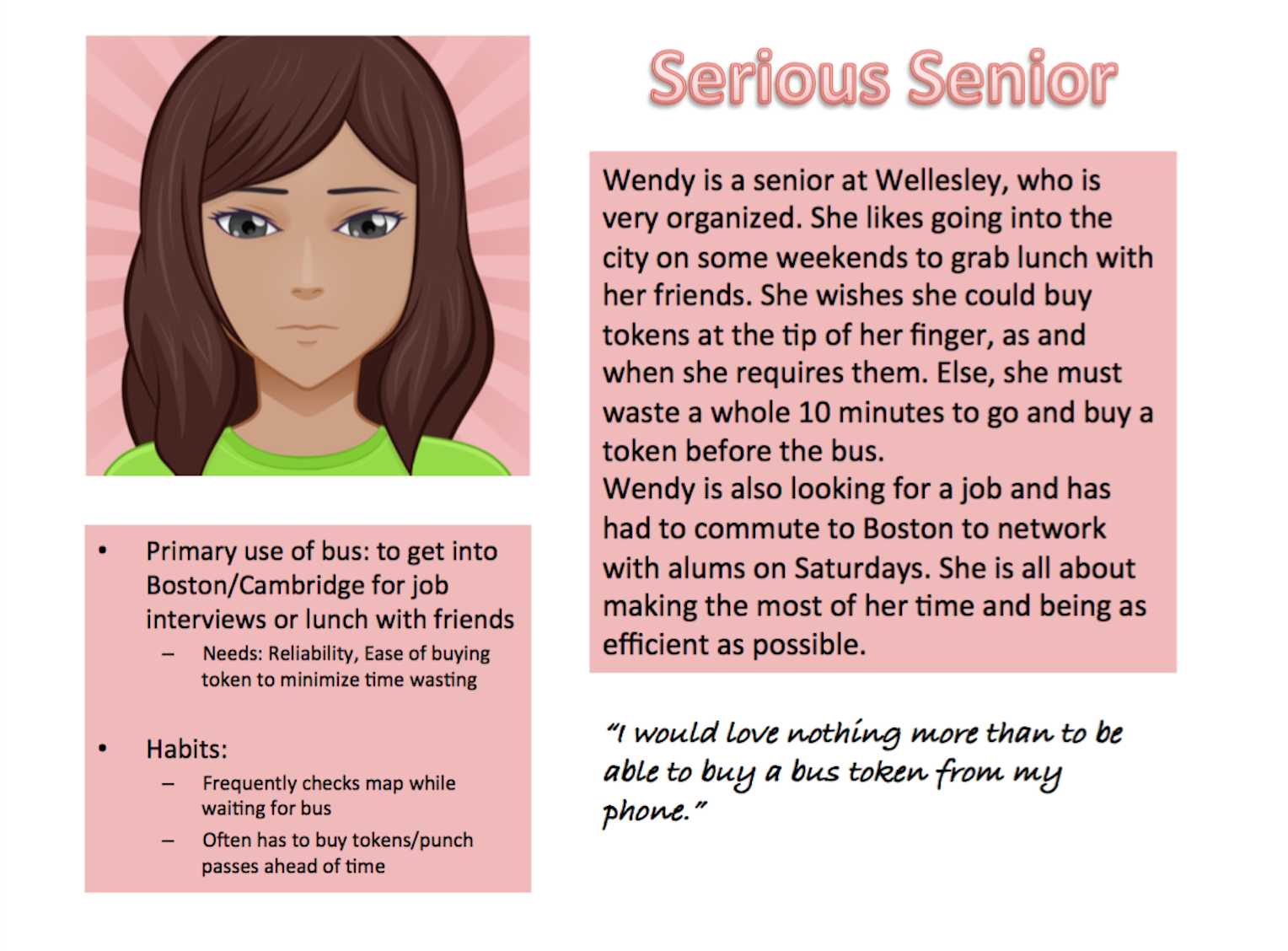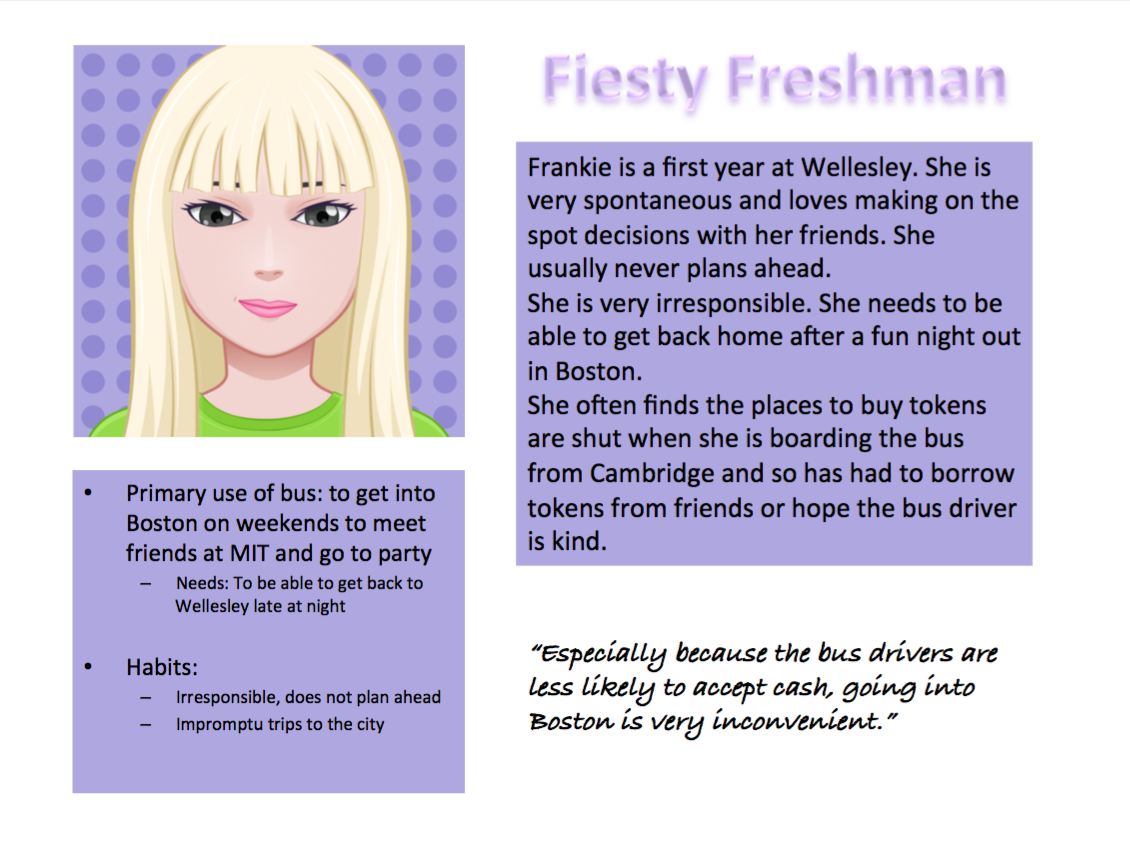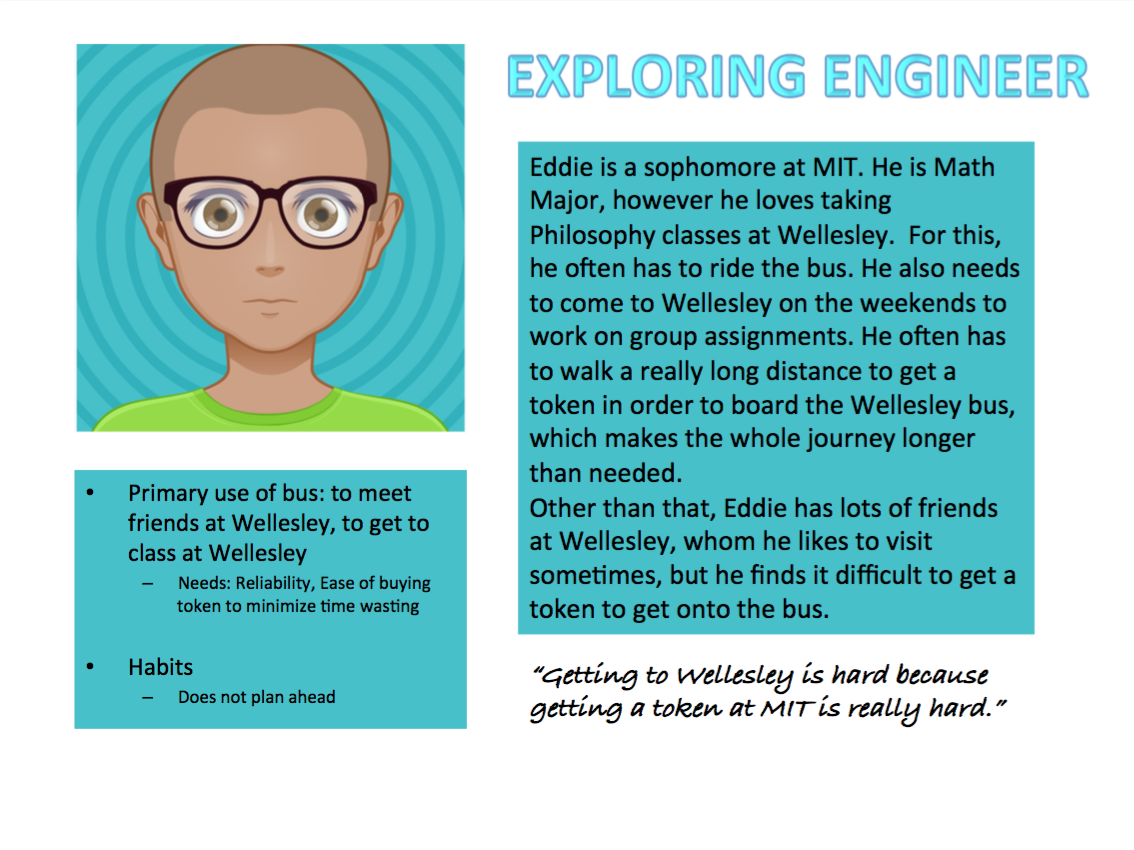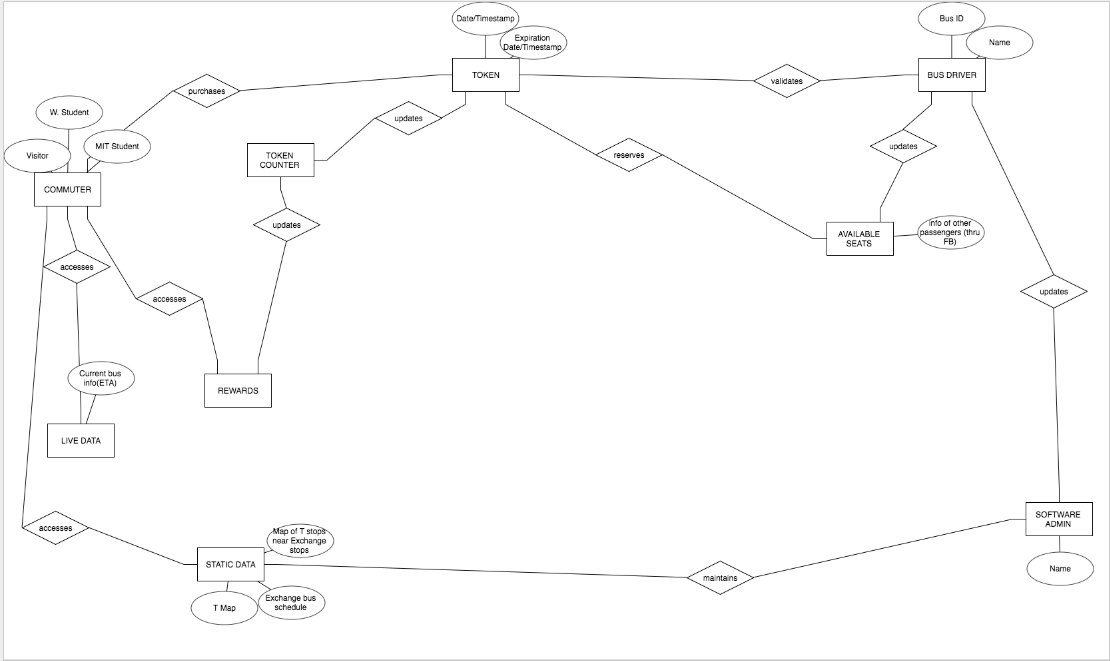P1: Requirements Analysis
- Personas
- Task Analysis
- Characteristics -
myPeter bus tokens are electronic, single-use, and unique. The current physical tokens are prone to loss and counterfeit, and require an additional time investment of walking to one of few vendors that sell the highly specific Wellesley College Bus Tokens.
With electronic tokens, students will never again beg bus drivers to let them pay in cash, which is forbidden of bus drivers by Peter Pan upper management. Students won’t have the opportunity to misplace their tokens and, in the event that they decide on a last-minute trip, can simply purchase a token on their or a friend’s smartphone. Sysadmin will not have to deal with eradicating counterfeit tokens or broken token machines.
Electronic myPeter tokens will be a quick and easy alternative for students, and will reduce the headaches associated with physical tokens for all users (not only students, but also sysadmin and bus drivers).
Subtasks will include earning rewards for each purchase and having the option to make a reservation for one of 20 reserved seats on each bus. These are subtasks because they require the completion of a bus token transaction in order to occur. - Questions -
1. Where is the task of purchasing tokens performed?
Pre-meditated action precipitating a planned trip to Boston
On-the-go, as a last-minute decision to hop on the bus
2. What is the environment like?
Dorm room; library; other seated, quiet, calm location where planning occurs
Busy Boston streets, while running to catch the bus, on the line waiting for the bus
3. How often is the task performed?
Will range widely - Some students will travel into Boston every weekend and other will only travel into Boston once per semester
Task is only performed on the weekends when the bus requires a token, i.e. Friday after 5pm, Saturday, and Sunday
4. How is the task learned?
In-app prompts - Clear forward, back, and submit buttons
5.What can go wrong?
Incorrectly input credit card information, Purchasing too many tokens, Accidentally validating a token before the intended ride, Not having cell service/wifi when trying to make a last-minute purchase
6. Who else is involved in the task?
Friends - Students usually coordinate with friends to decide on which bus to take - Characteristics -
Currently, students manage their Boston transit experience over several apps. There is not one location to find Wellesley-specific Peter Pan information and Boston MBTA information.
This is a problem because the Peter Pan, in order to maintain efficiency, only makes stops at three locations in Boston. The city is obviously much larger than just three stops all located in Cambridge. In order to get to appointments and other engagements outside of Cambridge, students need to utilize MBTA public transit. Additionally, the Peter Pan bus is subject to traffic and maintenance constraints, and occasionally falls off schedule due to traffic or bus failure.
By pulling all transportation together under one metaphorical roof, students will have an easier, more streamlined travel experience. This will be especially advantageous for novice users who only travel into Boston occasionally and are not familiar with the MBTA bus and subway system. Even if experienced users have the MBTA maps memorized and know the Peter Pan schedule by heart, they will still appreciate the real-time bus ETAs. By making a supportive and meaningful connection with entire classes of users in this way, and possibly helping them to avoid disaster, we will build loyalty to our app and encourage users to keep coming back. - Questions -
1. Where is the task performed?
Before the trip: a planning tool for building an itinerary
On-the-go: checking bus ETAs while heading to the stop, pulling up the maps while wandering around the city
2. What is the environment like?
Dorm room; library; other seated, quiet, calm location where planning occurs
Busy Boston streets, at the bus stop
3. How often is the task performed?
For novice users, potentially multiple times throughout a trip to guide their trip from beginning to middle to end
For experienced users, once to check ETA for departing bus and once to check ETA for arriving bus
Task is performed on the weekends, as well as on weekdays, regardless of token requirement
4. How is the task learned?
In-app - Clearly labeled buttons and menus
5.What can go wrong?
Inaccurate real-time ETA data, no cell service/wifi to load real-time data, Human error in misreading a schedule or getting off at the wrong stop
6. Who else is involved in the task?
Friends - Students will often plan trips with their friends, involving going beyond Cambridge on the T
Sysadmin - Need to maintain updated static data (MBTA maps, Bus schedules) - Characteristics -
There have been many issues with the physical tokens. Nearly all the people we interviewed for our personas mentioned how difficult the current token system is. The tokens as we know them are physical objects, prone to theft or loss, and recently the subject of counterfeiting. myPeter will exclusively use electronic tokens, reducing the risk of theft, loss, and forgery, making myPeter a cost-effective transition for the College's Transportation Department. These tokens will be unique and single-use. Similar to the electronic tickets for the MBTA Commuter Rail, the tokens will have either a visual cue (gif, changing colors, etc.) to signal to the driver that this is a valid token or a QR code that can only be successfully scanned once.
- Questions -
1. Where is the task performed?
On the bus line
2. What is the environment like?
The busy bus entrance
3. How often is the task performed?
Once before leaving Wellesley on the bus, once before leaving Boston on the bus
4. How is the task learned?
(Visual cue) In-app - Clearly labeled and succinct buttons and menus
(QR Code) Driver training - Drivers will be trained by Peter Pan to use QR scanning devices
5.What can go wrong?
If QR code, driver might not be adept at using the scanner, students might validate too soon, students might buy too many tickets with no resale option, students might not have cell service/wifi to purchase last-minute tokens
6. Who else is involved in the task?
Bus Driver - The person who actually performs the action of the validation - Domain Analysis
User Analysis
Our users are anyone who utilizes the Peter Pan bus, either the MIT Exchange or Senate version. This group includes: Wellesley students; non-Wellesley, MIT students taking classes at Wellesley; and off-campus Wellesley students. These users, given their young adult status and statistical probability of owning a smartphone, could benefit from a streamlined Peter Pan and T app. By bringing the entire Wellesley Boston transportation experience to one app designed with the Wellesley-MIT bridge in mind, students will never again need to scramble for tokens or miscalculate the last T they can take before they miss the bus.
The three user classes are: 1. A student 2. Bus Driver 3. System Admin; each for which we have developed a persona.
Student
Wendy Wellesley

What is the age of your person?
21!
What is the highest level of education this person has received?
Currently a junior enrolled at Wellesley College (implying our user is very bright).
How much work experience does your person have?
Wendy worked at a lab at MIT this summer and has worked on various projects prior to this.
Why will they come to the app? (User needs, interests, and goals)
Wendy has an outgoing and bubbly personality. As she is originally from New York City, she loves spending time in Boston over the weekends as she enjoys the city life that it has to offer whilst she is at college. So, Wendy travels to Boston on Friday and Saturday nights usually, to meet her friends at other institutions such as MIT and Harvard. Being a college student, she ends up frequenting college parties, which end very late at night. She always takes the PeterPan bus (more commonly known as “Peter”) back to and from Wellesley as it is the most economical form of transport. In order to ride the Peter, she needs to carry tokens with her or buy a bus pass. The issue with tokens is that the Token machines are often empty, or they are broken. The bookstore, the entity selling punchpasses, often runs out of them. This results in Wendy often not having her own token, and so she has to borrow one from a kind hearted human being riding the bus or try and convince the bus driver to accept the $3 fare in cash (which the driver is not supposed to do). The same situation often arises when Wendy takes impromptu trips into Boston, resulting in not having enough tokens to ride the bus on the way home.
Furthermore, Wendy often makes plans with her friends in the city, only to realize that she can’t make it in time as there is no place in the bus. Our app aims to solve these problems. Being a millennial, Wendy does not leave her room without her smartphone. If she had myPeter, she could buy tokens on the go, and reserve a seat.
When and where will users access the site? (User environment and context)
Wendy is likely to use this app at Wellesley, in her room or on her way to the bus. She is also likely to use it while waiting for the bus in Boston. As she just turned 21, she can now legally consume alcohol. Thus, we need to make the purchase process for tokens very straightforward so that Wendy does not make errors if she uses the app after a party at which she consumed alcohol.
What technological devices does your person use on a regular basis?
Wendy’s iPhone is an extension of her hand. She is also familiar with using a laptop, iPads, android tablets and fitbits.
What software and/or applications does your person use on a regular basis?
Wendy is an avid user of instagram and snapchat.
Through what technological device does your user primarily access the web for information?
Wendy primarily uses her iPhone to access the web.
Bus Driver
Johnny Smith

What is the age of your person?
60
What is the highest level of education this person has received?
Johnny graduated high school in 1964.
How much work experience does your person have?
Johnny has worked as a bus driver for the last 20 years. Prior to that, he was the personal chauffeur to Donald Trump. He quit his last job as his employer refused to pay him.
Why will they come to the app? (User needs, interests, and goals)
Johnny really values his job as it is the only source of income for his family. He loves what he does as the Wellesley students who ride the bus are great to have conversations with as they remind him of his grand daughter. According to the rules, Johnny can only accept tokens or punchpasses from those riding the bus. However, in the past, he has accepted the cash fare from the students as he knows that the bus is their only way home. This resulted in Johnny getting into trouble because it is against the rules and so he stands to lose his job if he continues this practice. He is often faced with the dilemma as to whether he should let a student on late at night without a token and accept cash or leave them behind. This app will allow students to immediately buy tokens via the app, eliminating the need for Johnny to ever accept cash. While Johnny isn’t the one actually “using” the app per se, he will be responsible to validate the tokens purchased on the app, and so is an important consideration.
When and where will users access the site? (User environment and context)
Johnny will only interact with the app at the time of boarding, at each bus stop.
What technological devices does your person use on a regular basis?
Johnny uses his Nokia flip phone and recently learned how to send a text message!
What software and/or applications does your person use on a regular basis?
None. Johnny knows the basic features on his flip phone.
Through what technological device does your user primarily access the web for information?
He doesn’t; he asks his kids.
Sysadmin
Ivan McDonald

What is the age of your person?
35
What is the highest level of education this person has received?
Ivan graduated the University of Arizona in 1999 with a Computer Science degree.
Why will they come to the app? (User needs, interests, and goals)
Ivan currently works at Wellesley College, and is in charge of organizing the PeterPan buses for students. He coordinates with drivers and is responsible for making sure everything goes smoothly. Recently, there was an issue with fake tokens being used on the bus. Students had procured duplicates of the tokens being used on the bus and were utilizing them to avoid the fare of the bus. To address this issue, Ivan installed a new form of token. However, if he had myPeter, the issue of fake tokens would be eliminated because the app would be the primary source of token sales, and thus reduce the chance of counterfeit tokens.
In addition to his role in coordinating transport, he updates the Wellesley bus schedule online on days where the schedule is irregular. If myPeter existed, he would be in charge of updating the schedule and maintaining the static app data (maps, fun info, etc).
When and where will users access the site? (User environment and context)
Ivan will not be an active user per se, but will be in charge of making changes to the app. He will make these changes at the desk in his office, in Schneider Hall.
What technological devices does your person use on a regular basis?
Ivan is pretty tech-friendly. An avid user of his andriod, he recently purchased the Sony SmartWatch.
What software and/or applications does your person use on a regular basis?
Ivan knows how to update websites in html/css/javascript. He also knows how to modify the back end of an app. He’s a pretty adept CS major.
We decided to go further and analyze our end users, the student, in more detail. We divided this into 3 categories, as shown below:



Task 1: Students purchase bus tokens
Task 2: Access bus schedules, bus ETAs, MBTA T maps
Task 3: Validate the Token
Domain Analysis
Determine the important entities and relationshipsof your problem domain, and show them in an entity-relationship diagram(ERD).
Below is our first draft entity relationship diagram for myPeter. The graph is detailed and thorough but also flexible for future changes to the design
ERD - Draft 1
